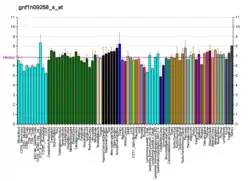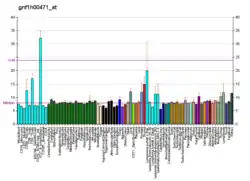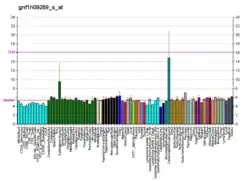PGPEP1
The PGPEP1 gene in humans encodes the enzyme Pyroglutamyl-peptidase I.[5]
| PGPEP1 | |||||||||||||||||||||||||||||||||||||||||||||||||||
|---|---|---|---|---|---|---|---|---|---|---|---|---|---|---|---|---|---|---|---|---|---|---|---|---|---|---|---|---|---|---|---|---|---|---|---|---|---|---|---|---|---|---|---|---|---|---|---|---|---|---|---|
| Identifiers | |||||||||||||||||||||||||||||||||||||||||||||||||||
| Aliases | PGPEP1, PAP-I, PGP, PGP-I, PGPI, Pcp, pyroglutamyl-peptidase I, PGI | ||||||||||||||||||||||||||||||||||||||||||||||||||
| External IDs | OMIM: 610694 MGI: 1913772 HomoloGene: 9793 GeneCards: PGPEP1 | ||||||||||||||||||||||||||||||||||||||||||||||||||
| |||||||||||||||||||||||||||||||||||||||||||||||||||
| |||||||||||||||||||||||||||||||||||||||||||||||||||
| |||||||||||||||||||||||||||||||||||||||||||||||||||
| |||||||||||||||||||||||||||||||||||||||||||||||||||
| |||||||||||||||||||||||||||||||||||||||||||||||||||
| Wikidata | |||||||||||||||||||||||||||||||||||||||||||||||||||
| |||||||||||||||||||||||||||||||||||||||||||||||||||
References
- GRCh38: Ensembl release 89: ENSG00000130517 - Ensembl, May 2017
- GRCm38: Ensembl release 89: ENSMUSG00000056204 - Ensembl, May 2017
- "Human PubMed Reference:". National Center for Biotechnology Information, U.S. National Library of Medicine.
- "Mouse PubMed Reference:". National Center for Biotechnology Information, U.S. National Library of Medicine.
- "Entrez Gene: PGPEP1 pyroglutamyl-peptidase I".
Further reading
- Kimura K, Wakamatsu A, Suzuki Y, et al. (2006). "Diversification of transcriptional modulation: Large-scale identification and characterization of putative alternative promoters of human genes". Genome Res. 16 (1): 55–65. doi:10.1101/gr.4039406. PMC 1356129. PMID 16344560.
- Valdivia A, Irazusta J, Fernández D, et al. (2005). "Pyroglutamyl peptidase I and prolyl endopeptidase in human semen: increased activity in necrozoospermia". Regul. Pept. 122 (2): 79–84. doi:10.1016/j.regpep.2004.05.005. PMID 15380924. S2CID 24844740.
- Minderman H, O'Loughlin KL, Pendyala L, Baer MR (2004). "VX-710 (biricodar) increases drug retention and enhances chemosensitivity in resistant cells overexpressing P-glycoprotein, multidrug resistance protein, and breast cancer resistance protein". Clin. Cancer Res. 10 (5): 1826–34. doi:10.1158/1078-0432.CCR-0914-3. PMID 15014037.
- Ota T, Suzuki Y, Nishikawa T, et al. (2004). "Complete sequencing and characterization of 21,243 full-length human cDNAs". Nat. Genet. 36 (1): 40–5. doi:10.1038/ng1285. PMID 14702039.
- Dando PM, Fortunato M, Strand GB, et al. (2003). "Pyroglutamyl-peptidase I: cloning, sequencing, and characterisation of the recombinant human enzyme". Protein Expr. Purif. 28 (1): 111–9. doi:10.1016/S1046-5928(02)00632-0. PMID 12651114.
- Strausberg RL, Feingold EA, Grouse LH, et al. (2003). "Generation and initial analysis of more than 15,000 full-length human and mouse cDNA sequences". Proc. Natl. Acad. Sci. U.S.A. 99 (26): 16899–903. Bibcode:2002PNAS...9916899M. doi:10.1073/pnas.242603899. PMC 139241. PMID 12477932.
- Gil J, Larrinaga G, Meana JJ, et al. (2002). "Regional and subcellular distribution of soluble aminopeptidase in the human and the rat brain: a comparative study". Neuropeptides. 35 (5–6): 276–84. doi:10.1054/npep.2001.0870. PMID 12030812. S2CID 39976173.
- Charli JL, Mendez M, Vargas MA, et al. (1990). "Pyroglutamyl peptidase II inhibition specifically increases recovery of TRH released from rat brain slices". Neuropeptides. 14 (3): 191–6. doi:10.1016/0143-4179(89)90044-9. PMID 2575716. S2CID 13735633.
This article is issued from Wikipedia. The text is licensed under Creative Commons - Attribution - Sharealike. Additional terms may apply for the media files.






